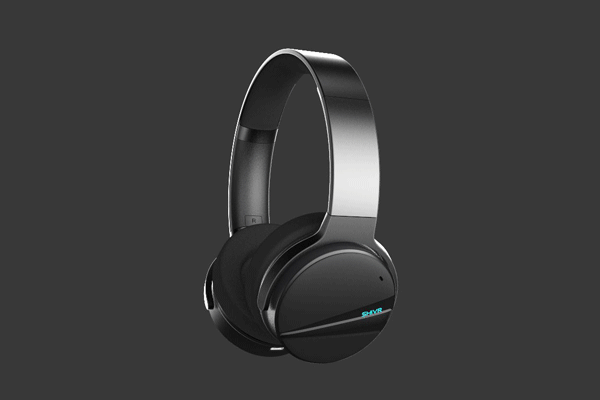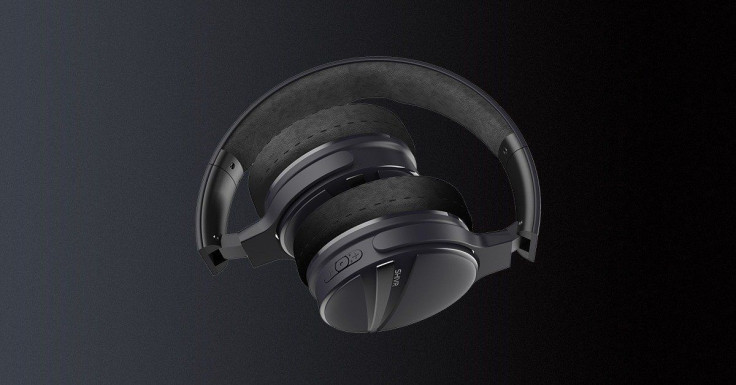The SHIVR headset is a new entry in the world of headphones, created in part due to a successful crowdfunding campaign. The headset boasts impressive features like active noise cancellation and 3D audio, with the intention of completely immersing the listener in whatever they happen to be listening to. While the SHIVR does offer some decent audio quality, and is a comfortable and lightweight headset to wear, the added bells and whistles can’t quite compare to other headset options.
Physically, the SHIVR is built quite nicely. The headset is lightweight, with soft ear cushions that don’t hurt your ears even after long stretches of use. The SHIVR can also fold up easily, making storage in a backpack a breeze. The buttons on the headset are easy to reach. I really like the simple on/off switch instead of a button you need to hold down for multiple seconds, like those found on many other headsets. From a hardware perspective, the SHIVR is an attractive, solidly built pair of headphones.

The SHIVR also shines for basic Bluetooth headphone use. Audio is clear, with an emphasis on mid-range sounds. This does mean you might want to look elsewhere if you want a booming bass, but I found there is a healthy audio mix when listening to all different varieties of music and audio. I found these headphones especially great for listening to podcasts with, as your average human voice comes through crystal clear.
I also appreciate that the SHIVR can be used both wirelessly with Bluetooth or can be directly plugged into something thanks to the included 3.5mm cable. This means you can use the same headset to listen to music on your commute, then plug it into your PS4 or Xbox One controller for gaming. Additionally, a built-in microphone means you can make hands-free phone calls.
Another big highlight is the active noise cancellation on the headset. The noise cancellation is on by default, and does a decent job of blocking out the world around you, especially when listening to music. I don’t think I have used a noise cancelling headset that worked as well as the SHIVR for a comparable price.
The SHIVR’s battery life is also pretty great. I have only charged the headset once since use, and I have never run out of juice, even with the active noise cancellation activated. I do wish there was an easy way to check how much battery life is left, but that feature is surprisingly rare in wireless headphones these days.
However, that’s where the SHIVR’s notable accomplishments come to an end. There is built-in 3D audio, but it doesn’t work very well. If you are listening to something with one source of audio, like a voice on a podcast or a singer without any accompanying music, the 3D audio makes a strange echo effect, and doesn’t really have the same impact that something like the Audeze Mobius has.
When listening to a more traditional song with multiple instruments, the 3D effect is noticeable, but only just. While other 3D audio headsets I’ve used create a fixed point that make it sound like audio is coming from, the SHIVR seems to be constantly changing the point. This means when you turn around, audio shifts slightly, then updates to make it sound normal again. It’s hard to have directional audio when the direction keeps changing with every movement of your head.

I rarely found myself using the 3D audio, as at best, it is a slightly interesting gimmick. At worst, it can make listening a chore. I found myself trying to figure out if the 3D effects were even working, or if I had not turned on the feature or calibrated it properly.
Of course, comparing the SHIVR to something like the Audeze Mobius is a little unfair when considering the price. The SHIVR is $200, while the Mobius is double that price. That said, if you were hoping to get comparable performance in a less expensive headset, the SHIVR is not the device you want.
Speaking of the price, the SHIVR does start to drastically lose its appeal when you compare performance to price tag. While the headset is a pretty high-quality standard pair of headphones, you can easily find a less expensive headset (even one that includes active noise cancellation) that can perform on par with the SHIVR without 3D effects.
Ultimately, the question boils down to ‘is the SHIVR headset worth the price?’ Unfortunately, I don’t think it is. While the SHIVR offers decent audio quality and some surprisingly great noise cancellation features, the 3D audio effects just don’t work well at all, and actually make the listening experience worse. If you’re in the market for a solid pair of Bluetooth headphones, you can find better options for less. If you want immersive 3D audio, you’re going to need to pay the big bucks for something like the Audeze Mobius, or wait until a different headset can offer something comparable.
The SHIVR headset is now available to pre-order on Indiegogo. Headsets are expected to start shipping soon.
So what do you think? Are you interested in the SHIVR headset? What headphones do you currently use? Let us know your thoughts in the comments section below.


















